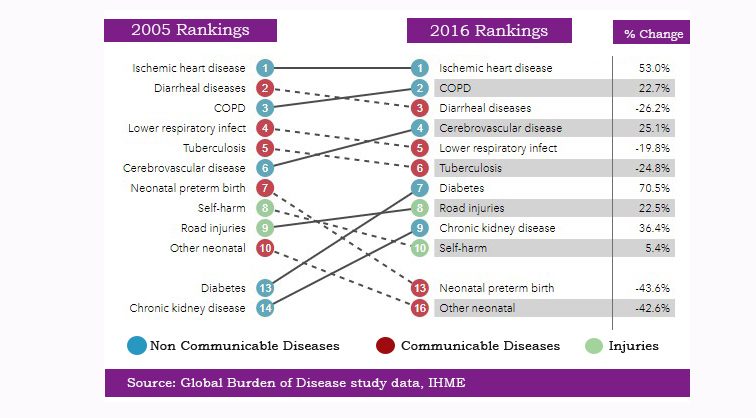
Non-Communicable Diseases & Injuries continue to be the largest killer in India
The Global Burden of Disease (GBD) 2016 data released on 15th September reveals that Non-Communicable Diseases (NCDs) & Injuries continue to be the main cause of death among people of all age-group in India.
According to The Global Burden of Disease data for India, the life expectancy has been growing steadily over the past decade, but the country still suffers from some major disease burdens like ischemic heart disease, pulmonary disorders, cerebrovascular disease and chronic kidney disease.
Ischemic heart disease was the leading cause of death in India (both among men and women) with an increase of 53% from 2005 followed by Chronic Obstructive Pulmonary Disease (COPD) which saw an increase of 22.71% from 2005 data.
Diabetes and Chronic Kidney Diseases (CKD) saw a major increase from their 2005 levels with 70.5% and 36.42% respectively. Non-Communicable diseases also emerged as the major contributor to the rising percentage of Disability-Adjusted Life Years (DALY) in the country.
Commenting on the Global Burden of Disease (GBD) 2016 data, Dr Vivekanand Jha, Executive Director, The George Institute for Global Health said,
"The contribution of Non-Communicable Diseases to death and disability in India continues to grow at an alarming rate – a ticking time bomb that is increasingly affecting not just our health but our economy as well. As per the Global Burden of Disease (GBD) 2016 data released through Lancet, over 6 million deaths have occurred due to NCDs in the country in 2016.
The two largest increases were seen in diabetes and chronic kidney disease. The report points out the value of knowing these cause-specific mortality data in framing action to meet Sustainable Development Goals (SDG), and highlights the continued neglect by the SDG agenda to some important causes of health burden, of whom chronic kidney disease is particularly relevant to India, having risen to 9th place in the rank of causes of death.
There is an urgent need to pay attention to the healthcare and monitoring needs of these conditions.”
A very important section of the India population is adolescents & youth. This section forms a huge chunk of our population and their concerns and issues need to be heard and addressed. The GBD 2016 data reveals that Self-Harm continues to be the largest cause of death among people in the age group of 10-24 years. Road Injuries, Drowning, Ischemic Heart Disease and Interpersonal Violence form some of the other major reasons for mortality among this age group.
Further analysis of the data shows that risk factor management is a key area of focus and needs immediate attention at the highest level. High Blood Pressure, Dietary Risks, Tobacco, Cholesterol and Body-Mass Index and some of the top contributors to most death and disability combined in India.
The GBD data also shows that dietary habits, tobacco use, blood sugar, obesity and low physical activities are the major metabolic and behavioural risk factors which lead to NCDs in India. These need to be identified early and program and policy level interventions need to be put in place immediately in order to reduce the burden of NCDs in the coming future. The key to this will be awareness and education starting at an early stage in life among students.
The Global Burden of Disease (GBD) is the largest and most comprehensive epidemiological effort to quantify health loss across places and over time. It draws on the work of over 2,500 collaborators from more than 130 countries and territories. The study is coordinated by the Institute for Health Metrics and Evaluation. This year, more than 13 billion data points are included; the papers comprise a complete edition of The Lancet.
Access more details on the Global Burden of Disease data on India

